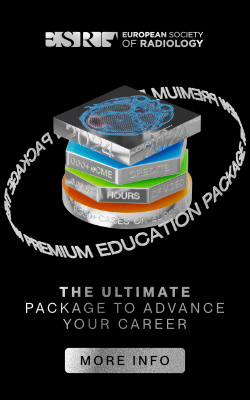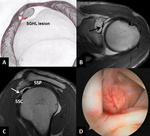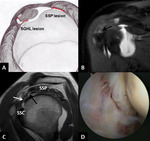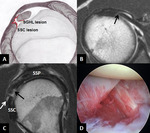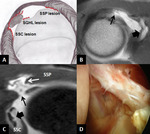Purpose
Antero-superior impingement (ASI) of the shoulder is a form of internal impingement related to shoulder pain which occurs especially in athletes.
The etiology of this syndrome is not clear but seems to be directly related to rotator interval lesions and instability of the long head of the biceps tendon (LHBT).
The aim of our study is to assess the role of arthro-MRI in diagnosis of rotator interval tears and the correlation with development of ASI of the shoulder.
Methods and Materials
We retrospectively reviewed and analyzed arthro-MRI exams of 23 patients (20 males and 3 females) who underwent arthro-MRI exam with a 1.5 Tesla device and arthroscopy within successive 2 months.
All patients were athletes clinically suspected of ASI,
positive to Palm-up,
O’Brien and Hawkins tests.
The shoulder was studied with dedicated coil in neutral,
intra and extrarotated position.
ABER position was used in 8 patients.
Intra-articular injection of contrast agent (Gd-DOTA) was made under fluoroscopy.
Artro-MRI protocol included proton density-weighted (PD-w) sequences with and without...
Results
In our patients we found a narrow broad of lesions which were classified at arthro-MRI into 4 groups on the basis of Habermeyer arthroscopic classification: 3 patients had superior gleno-humeral ligament (SGHL) tear (Type I) (Fig.1),
5 patients had SGHL and supraspinatus tendon (SSP) tears (Type II) (Fig.2),
7 patients SGHL and subscapularis tendon (SSC’s) tears (Type III) (Fig.3) and 8 patients SGHL,
SSP and SSC tears (Type IV) (Fig.4).
Arthroscopic evaluation demonstrated that 1 patient had Type I,
5 patients Type II,
5 patients...
Conclusion
Rotator interval lesions include SGHL,
SSP and SSC tears with variable involvement of each of them.
Habermeyer first described the combination of these tears with arthroscopy.
According to this classification we propose an initial diagnosis with a Type I,
II,
III and IV pattern.
Arthroscopic findings matched the proposed initial diagnosis as shown in Table 1.
Arthro-MRI confirmed its excellent accuracy in the diagnosis of rotator interval tears; its limits are mainly related to the low specificity in the identification of SGHL tears.
On the...
References
1.
Habermeyer P,
Magosch P,
Pritsch M,
Scheibel MT,
Lichtenberg S.
Anterosuperior impingement of the shoulder as a result of pulley lesions: a prospective arthroscopic study.
J Shoulder Elbow Surg.
2004 Jan-Feb;13(1):5-12.
2.
Gerber C,
Sebesta A.
Impingement of the deep surface of the subscapularis tendon and the reflection pulley on the anterosuperior glenoid rim: a preliminary report.
J Shoulder Elbow Surg 2000;9:483-90.
3.
Struhl S.
Anterior internal impingement: an arthroscopic observation.
Arthroscopy 2002;18:2-7.
Karistinos A,
Paulos L.
Anatomy and function of the tendon of...
Personal Information
Giuseppe Lanni MD,
Department of Radiology
University of L'Aquila,
Italy
[email protected]
